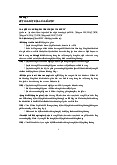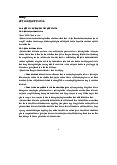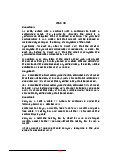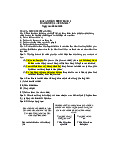









Preview text:
Chapter 2: The company Start up
Self-employed people have to do everything themselves. A plumber, for example, has to buy his
own tools and equipment, carry out the work himself, decide how to advertise his business, and
fix his own price scales. If he needed to raise capital for a business investment (such as a new
van), he would arrange a loan from the bank. He would also do his own book-keeping and,
possibly, his own tax declarations. He may decide to take on an assistant to lighten his
workload. However, as companies expand and more people are employed, one person can no
longer perform all the administrative and decision-making functions. Organization, and the
division of labor, is required.
In larger businesses, there must be people who can take authority for certain decisions and who
can tell other employees what to do. A typical chain of command would start with the Chairman
at the top, then the Chief Executive, followed by (in large organizations) the heads of divisions
(such as the Group Finance Director), then the heads of departments (such as Sales and
Marketing, Human Resources, Finance, etc.), and finally the people who work in the office or on the shop floor.
Every person in an organization is a member of a formal group within which he or she has to
perform specific tasks. This breakdown of an organization into formal groups offers a number of
advantages: workers specializing in specific areas can perform more effectively, which reduces
company costs; there is a clear chain of command as employees receive instructions from their
line manager; the employees9 performance can be monitored more easily; and there is better
internal communication as manager can speak for the section they control. At the same time,
employees can experience the benefits of working in a team, and they can also ask their
supervisor or more experienced colleagues for help and guidance.
Of course, a departmental organization can also have certain disadvantages: some employees
may be so focused on their own particular tasks that they become cut off from employees in
other departments; and managers may be more concerned with their own and their department9s
performance that with the overall performance of the company. 10 Questions:
1. When does a company need a loan?
2. Why do large companies have the chain of command?
3. Why can the breakdown of an organization reduce its costs?
4. Which type of organization do you support, centralization or decentralization? Why?
5. Find words or phrases in the text which mean:
- Money that somebody borrows from the bank
- How well somebody does their job
- A helpful and useful effect that something has Vocabulary
1. Work in pairs. Discuss what you think these people and departments do.
Example: I think the Purchasing department buys things the company needs
2. Match the departments (1-7) and descriptions (A-G).
1. It deals with billing, salaries, taxes, investment, and budgets.
2. It is responsible for advertising and market research. It organizes the selling of the products.
3. It produces the finished products.
4. It deals with staff and is responsible for recruiting and training.
5. It organizes the maintenance of the buildings, including office space.
6. It is responsible for the computer systems, and train staff in computer use.
7. It is responsible for buying the materials the company needs to make its products. 11
3. Which departments do these people work for? Complete the chart. R & D IT Finance Facilities Purchasing Customer Administration Care Sales & Marketing Distribution Managing Human Production Director Resources Javier Navarro Elena Morales
we are producing the annual accounts= Andrew Symonds
the moment. It9s a busy time!= Steven Baines promotion opportunities= 12
materials such as catalogues and
properly packed and labeled before they brochures= are dispatched= Mitsuko Saito Ray Clarke
around the building this month=
each stage of the manufacturing process= Philip Král Dean Wilson
protection on our whole system= suppliers= Agnes Laforgue David Lee
exciting range of new products=
meetings to making travel arrangements. Lisa Papi It9s non-stop! Penny James Wordcheck
Find the hidden words in this square. You can read from left to right, from top to bottom and
diagonally. Use the clues below to help you. H X Y W A R E H O U S E Z E X S Y Z X Y M Z U X Y X A X T Y Z R A X B R Z X Y D Z A E X N Y S E X Z R Y Q M F Z U X I V Z Y X A U U Y F F Z D E Y X Z S N X A Y A Z I N Y Z N Z X G Y R C Z A U J O I N T V E N T U R E C X Y N Z X Y Z U E Y S Y Z E F A C T O R Y R Z X R Y Z X Y Z X E Y Z S 13
1. The main office of a company (12)
2. The people who work for a company – its employees (5)
3. A large building where goods are stored (9)
4. A building where goods are made (7)
5. A person who buys and uses goods or services (8)
6. A company that is controlled by another company (10)
7. To produce in large quantities with machinery (11)
8. The total sales of a company (8)
9. A group of products sold by one company (5)
10. A regular payment for use of land, building, offices, machinery, etc. (4)
11. A cooperative operation between two companies (5,7) Reading
1. Read the introduction to the article. Then with your partner, discuss how we use the
Internet in business.
Examples: emails, booking flights, advertising E-commerce
You probably use the Internet to send emails, download music and films, or look for
information. But did you know that the Internet is transforming the business world?
Electronic commerce (e-commerce) is the buying and selling of products and services on
the Internet instead of using shops, phones, faxes, and letters. It creates opportunities for
companies to sell more and to improve customer service. It also gives customers greater choice.
There are three main types of e-commerce. The first is Business to Consumer (B2C) – the
consumer buys goods or services from a company on the Internet. Many consumers now
buy books, music, or tickets on the Internet. The second type of e-commerce is Consumer
to Consumer (C2C) – people sell and buy directly on sites such as eBay. The third type is
Business to Business (B2B) – commerce between companies. They use the Internet to
order goods, get services, and manage their business. It is fast and efficient.
In the past, the car manufacturer Ford ordered thousands of parts from hundreds of
different companies. They told the suppliers which parts they wanted and the supplier sent 14
a proposal to supply them. It was a long and expensive process. These days, Ford uses
special B2B electronic exchanges to order their parts and then the suppliers put in
electronic bids for the job. This process is much quicker and cuts costs. Companies don9t
need large Purchasing departments and suppliers have to cut their prices to be competitive.
So which parts of the world are most 8e-active9? Europe is number one, the US comes to
second, while Hong Kong is the biggest in Asia-Pacific, particularly in e-business services.
In fact, in 2006, Europe9s three major markets – the UK, Germany, and France – carried
out around 25% of their sales online. This figure is increasing from year to year.
2. Read the article and match the definitions to the terms. 1. Order a. buying 2. Supplier
b. a price that a company offers to do work or
supply parts for if it wins the order 3. Bid
c. to request goods from a company 4. Costs
d. a person or organization that provides goods or services 5. Purchasing
e. the amount of money spent on running a business
3. Read the article again and decide if the sentences are true (T) or false (F)
1. Electronic commerce uses phones and faxes to do business.
2. B2C is when a consumer and a company do business together.
3. B2B is when private individuals sell or buy things on the Internet.
4. Ford used B2B in the past but didn9t get good results.
5. When a company uses B2B they save money and time.
6. A quarter of all European business is done online.
4. Complete the sentences with the words from <2=.
1. David, the budget is only €12,000 for this project. Please be careful with the . 2. I9d like to
fifteen office desks and chairs from the New Dawn range. 3. ADG Construction put in a
of €120 million to build the stadium. 4. We have found an excellent
in Spain for our engine parts.
5. Beamish Electronics have appointed a new buyer to their department. 15 Speaking
1. Business know-how – how to manage your time
a. Make a list of all the tasks. Then decide if their deadline is urgent or not.
b. Prioritize the most important task.
c. As you finish a task, cross it off your list.
d. When you complete a task, move on. Don9t be a perfectionist.
e. Concentrate on the task you are doing. Don9t be distracted by emails and text messages!
f. Find a place to work that suits your working style.
Which do you think is the best one? Do you do any of these things already? Do you have any other ideas?
2. What are the advantages and disadvantages of departments a. For the company? b. For employees?
3. What do you think? Is it better to work
a. In a small company and learn lots of different jobs?
b. In a large company, in one department, and specialize?
4. Discuss the advantages and disadvantages of e-commerce. Writing Thanking letter Label the parts of the letter □ Opening salutation □ Closing sentence □ Full name (typed) □ Closing salutation □ Writer9s address □ Signature □ Date □ Body □ Recipient9s address 16 45 Dale Road1 Stevenage SG6 6SB UK Sandman Creek Summer camps2 1831 Ellis Avenue Eugene OR 97405 25 November, 20 3 Dear Mr. Hemingway4,
I am writing to thank you for the interview we had yesterday. I am very interested in working
in your summer camp next year. I hope that my qualifications and interests were suitable. I
meant to also mention that I am learning to drive and I hope to have my driving license before the summer. 5
Once again, thank you for seeing me. I look forward to hearing from you. 6 Yours sincerely, 7 Amanda Nash 8 Amanda Nash 9 Dilemma & Decision Mission: Impossible? Brief
Louis Schweitzer, the 59-year-old CEO of the Renault group, has just received the latest
results for Nissan, the Japanese car manufacturer in which Renault has a 37 percent stake. The
situation looks bad. Nissan has lost money for the sixth consecutive year, the company9s debts
have now soared to a record $19 billion and they are now losing $1,000 on every new car they
produce. Clearly something needs to be done to return Nissan to profit quickly. The time has
come to appoint a new CEO. There is only one name that comes to Schweitzer9s mind: Carlos
Ghosn, the tough results-oriented director of Renault9s engineering division. He would be just
the person for the job. But how to convince him to accept what looks like an impossible mission? Task 17
Prepare to discuss the assignment to head Nissan. Decide what outcome you want from the
discussion and make notes to support your case. Guidelines
Louis Schweitzer is the CEO of the Renault group and the partnership with Nissan was
largely his idea as he considered it to be a key element of your strategy to make Renault a truly
international company. If the alliance fails, it will be disaster for the company. Your career is
now coming to an end and you plan to hand over control of the group within the next five
years. Anyone who can turn Nissan back to profit within a relatively short time might be just
the right person to take his place. Carlos Ghosn might just be that person. Louis Schweitzer
knows that he has a reputation as a man of action who takes quick decisions and who likes to
do things his own way. Make a list of the arguments that you will use to persuade him to accept the position.
• If he is successful, he could become the next director of the group.
• ……………………………………………………………………………………………
Carlos Ghosn is the manager of Renault9s engineering division where you have worked for
the last three years following an international career in the USA and Latin America with the
Michelin tyre company. He knows that Louis Schweitzer is considering him for the position of
CEO at Nissan but he has certain reservations about accepting the assignment:
• He has no experience of working with the Japanese
• Is his direct style of management compatible with the Japanese style of doing business?
• He would need to cut costs by eliminating jobs and factories – would this be politically
acceptable to the Japanese employees and authorities?
• Failure in this mission could damage his long-term career prospects.
How will he respond if Mr. Schweitzer offers him the position? Make a list of the things that
he would like Mr. Schweitzer to do if he is to accept the position. Japanese culture
The Japanese have a strong sense of belonging to Japanese are loyal to their organizations and will usually accept management decisions which
have been made to preserve or enhance the profitability of the organization as a whole.
Foreigners may have difficulty being accepted by the Japanese especially if they do not 18
understand the subtleties of the Japanese language and the sometimes vague way that things
are expressed. Negotiating and decision making often take place outside any formal meeting
context and action is only taken after thorough consultation with the people concerned. 19




